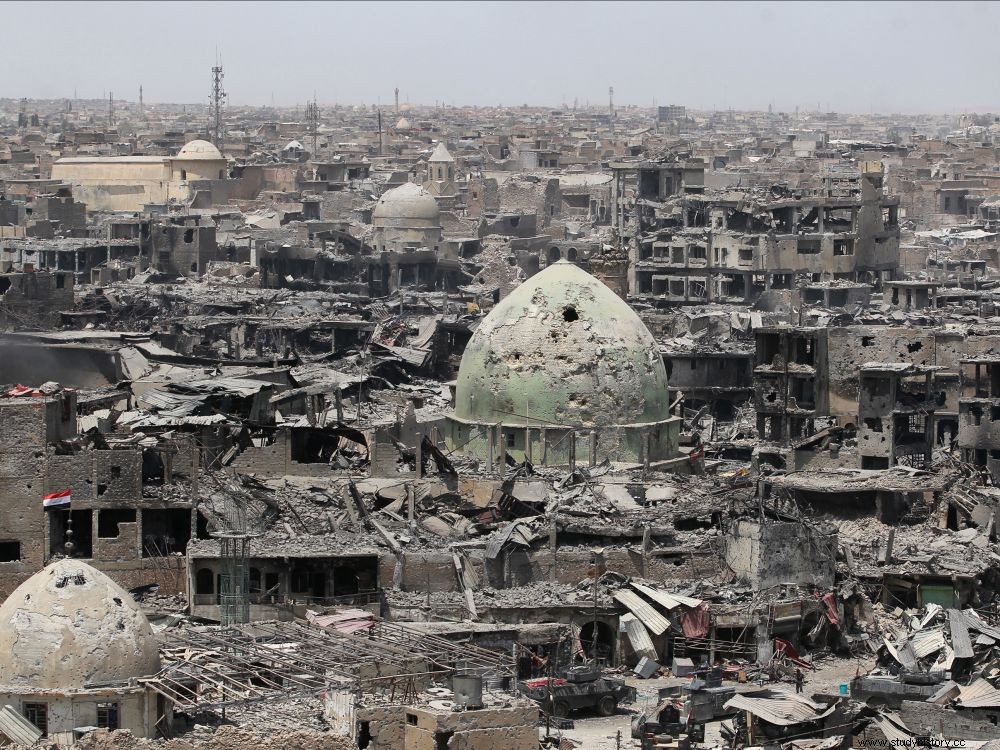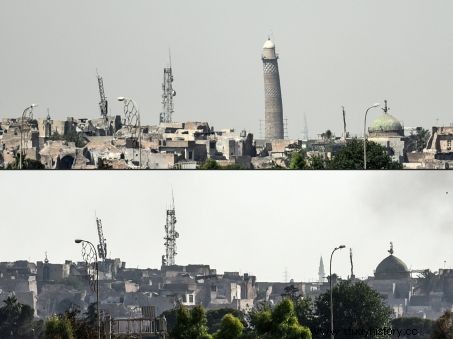The "old city" of Mosul was retaken from the hands of the Islamic State group after 266 days of intense fighting. A look back at the destruction of the heritage of the martyred city.

The "old city" of Mosul, Iraq's second city, when it was liberated on July 9, 2017.
After a 9-month offensive, the "capital" of the Islamic State (IS) in Iraq "fallen" in early July 2017, coming under the command of Iraqi forces. The liberation of the entire city of Mosul was announced by Iraqi Prime Minister Haider Al-Abadi, as images of terrible destruction flashed across the screens. Seen from the sky, Iraq's second city is no more than a pile of jagged blocks strewn with numerous corpses. Gutted buildings, burning houses, collapsed buildings.
Since 2014, jihadist groups had taken control of Mosul, Iraq's second city. Beyond the criminal abuses on the population, these terrorist militias carried out a real "cultural cleansing". Thus, in these lands near Nineveh, the ancient capital of the Assyrian Empire, the Islamists of the IS, in July 2014, destroyed with explosives the tomb of Nabi Younis (prophet known in the Bible under the name of Jonah), claiming that this Muslim pilgrimage site had become a place of apostasy.

The Nabi Younis mosque, after its destruction in July 2014. Credits:Khalid Mohammed AP/AFP
Jewel of the Assyrian Empire Nimrud was bulldozed
Before demolishing, in February 2015, the Archaeological Museum of Mosul with the aim of creating a stunning effect in the world thanks to the dissemination of images, in particular those of the destruction of a lamassu , colossal winged bull with a human head. This violence prefigured a succession of other large-scale destructions of nearby heritage sites:Hatra (1st. BC – 1 st s. AD), a Parthian city inscribed on the UNESCO World Heritage List; Nimroud, one of the jewels of the Assyrian empire destroyed by bulldozer; Khorsabad, Dour-Shar-rouken , the "fortress of Sargon", the capital of the Assyrian Empire (8th century BC) (read Sciences and Future N°818 ).
More recently, in June 2017, IS jihadists continued their iconoclastic destruction by blowing up the Al-Nouri Mosque, Mosul's treasure trove with its iconic tilted 12th-century minaret. The very place where Abu Bakr Al-Baghdadi, the self-proclaimed "caliph" of IS, made his only public appearance.

The Al-Nouri Mosque, and its iconic 12th century minaret, before and after its destruction by IS. Credits:Mohamad el-Shahed / AFP
The UN estimates the reconstruction of Mosul's infrastructure alone at more than a billion dollars
Similarly, the terrorist militias have never ceased to destroy the rich Christian historical heritage of the city "of the forty prophets ". Like the monastery of St Elie, built in the 6th century, the oldest Christian building in Iraq, destroyed in 2014; the Church of Notre-Dame-de-l'Heure or even Ste Marie de Mosul, burned in February 2015. In the old city, only the Chaldean Christian church of St Thomas of Mosul would still have some walls standing.
When the eastern sector of the city was liberated in February 2017, archaeologists who returned immediately to the site made a surprising discovery:under the ruins of the tomb of Jonas (Nabi younis), they found the remains of an Assyrian palace unknown to the 7th century BCE! It had appeared accidentally during tunnel digging carried out by IS. In March-April 2017, as part of a UNESCO reconnaissance mission, experts from the French company Iconem, which specializes in the digital preservation of endangered heritage, were able to enter it:"L' EI had dug these galleries starting from the entrance of an old archaeological dig... explains to Sciences et Avenir , Yves Ubelmann, the founder of the young start-up.In this labyrinth, we were asked to carry out, using scanners, the 3D surveys of frescoes of impressive Babylonian bulls which were put there day ». The UN has just valued the reconstruction of Mosul's infrastructure alone at more than a billion dollars.
